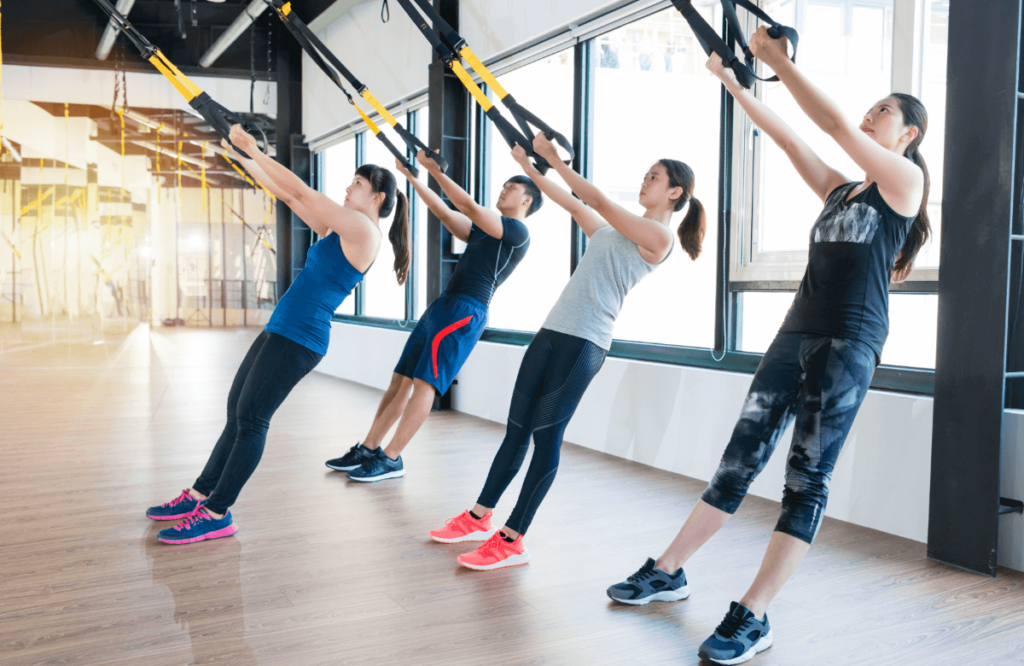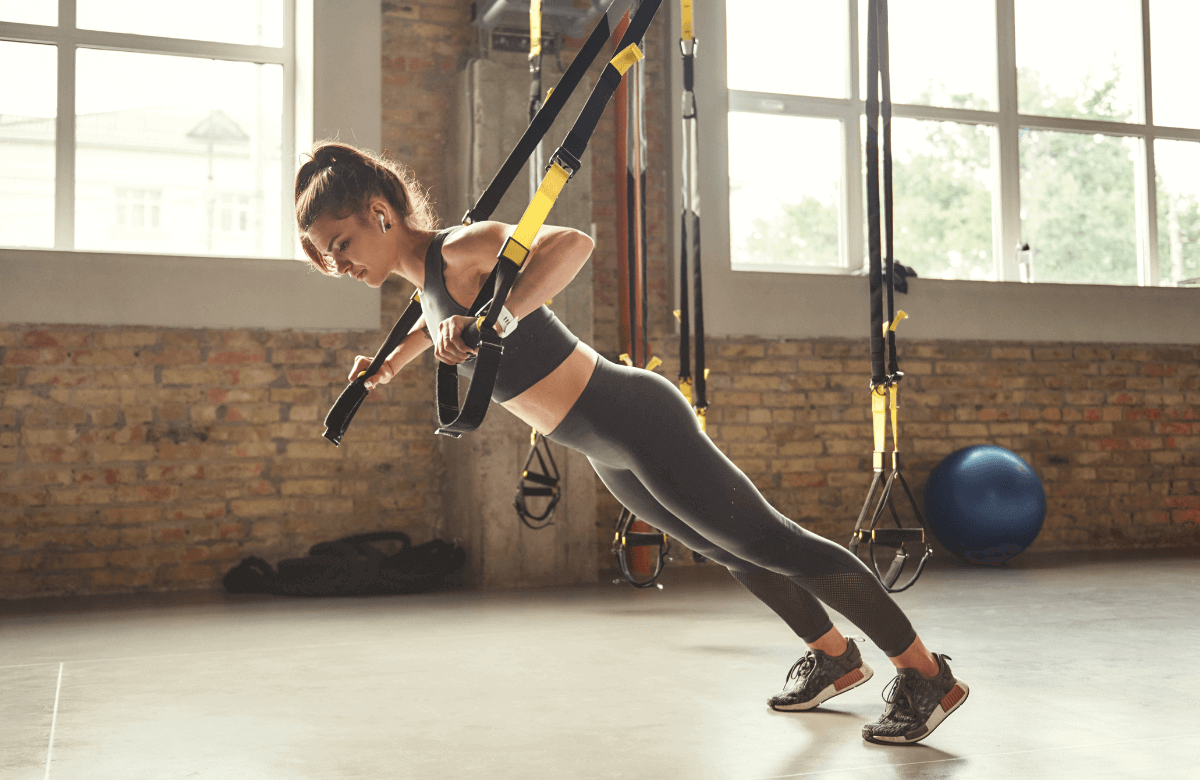Suspension Trainers have gained popularity, becoming an incredibly versatile option that provides a comprehensive workout from nearly anywhere.
TRX workouts are one of the most popular options, as they’re durable, high-quality, and easy to use.
But you’ll need the best exercises to get the most out of your TRX Suspension Trainer. We’ve compiled the 10 Most Effective TRX Workouts in the article below to give you a head start on your fitness journey.
Jump to:
What Is TRX?
The Total-Body Resistance Exercise, or TRX for short, was created by Navy SEAL Randy Hetrick in the early 2000s.
The tool is used for Suspension Training, or bodyweight exercises where you grip onto two straps made of parachute webbing or suspend your feet with foot cradles. Hetrick developed the tool as a way for him and his team to maintain high levels of fitness with limited equipment and space.
Leveraging your own body weight against gravity allows you to create varying ranges of resistance depending on the movement. The TRX Suspension Trainer is a versatile piece of equipment that will enable you to train the entire body.
TRX Benefits
TRX Suspension Training has much more benefits than drawbacks. Suspension trainers can provide a comprehensive fitness routine targeting the lower and upper body. They’re simple to use, portable, and work for all fitness levels.
Here are some more benefits of TRX Suspension Trainers:
Train Nearly Anywhere
TRX Suspension Trainers were initially created as an easily portable training method. It can be anchored to nearly anything that will support your body weight—doorways, racks, trees, posts, and other sturdy objects.
It’s small enough to fit into a backpack, gym bag, or suitcase. This design lets you take your body training tool nearly anywhere, allowing for more muscle growth and development.
Accessible for All Fitness Levels
TRX Suspension Trainers can suit your workout routine, regardless of where you are on your fitness journey. Because you’re using bodyweight against gravity, there aren’t any heavyweights or dumbbells.
You can increase the difficulty by using more or less resistance, increasing the rep range, changing the range of motion, or performing more sets.
This makes the TRX an excellent tool for beginner workouts or as a means to progress with bodyweight training.
Enhances Strength and Coordination
The TRX is fantastic for enhancing body strength, coordination, and core stability. The different exercises allow you to total body muscle activation while constantly engaging the core and stabilizer muscles.
Because the core muscles are consistently engaged, the TRX is an excellent fitness method for developing functional strength. Over time, daily activities like walking upstairs, bringing in groceries, and moving boxes will become easier.
Full-Body Workouts
TRX Suspension Trainers allow you to engage the entire body through fundamental movement patterns. You can engage the upper body through exercises that target the chest and shoulder muscles.
Or you can target the quadriceps, hamstrings, and glutes through regular squats and variations.
You can engage all of these muscle groups in a session or break it up throughout the week. Regardless, the TRX is a fantastic tool for developing muscle mass, core strength, and stability.
The 10 Best TRX Workouts

1. Push-Ups
Regular push-ups are one of the cornerstones of a good calisthenics routine. Instead of traditional push-ups, the TRX allows you to perform Suspended Push-Ups.
This variation thoroughly engages the chest muscles and secondary muscles, as you have to keep your body stable. If you’re just starting out, it might be better to stick to regular push-ups until you have more strength.
How to perform Suspended Push-Ups:
- Prepare the TRX straps so they’re set up above the ground. You can choose how high to place them, but having them lower will make it more challenging for your chest muscles.
- Hold the handles in a way that the grip rests comfortably in the center of your hand. Make sure your wrist stays in a straight line.
- Engage your core muscles and keep your hips from dropping. Begin the descent by bending your elbows, aiming to keep them close to your body at a 45-degree angle. If it feels comfortable, slightly turn your hands outward.
- Lower your body all the way down until your chest goes past your hands. This is an advantage of TRX push-ups because it lets you stretch your chest muscles more deeply. Push your hands down toward the ground to lift your body up.
2. Dip
Dips are already challenging on their own, but the TRX raises the bar exponentially. The Suspended Dip requires you to support your body on hanging handles, making it a powerful movement for engaging the upper body and abdominal muscles.
If you’re a beginner, it’s best to start with traditional dips or chair dips. Otherwise, use a solid handle and follow the steps below.
How to perform the Suspended TRX Dip:
- Modify the straps to the right height. Hold the handles so that they rest in your palm near your thumb, which keeps your hand in a straight line.
- Jump and use your strength to lift yourself to the starting position with your arms fully extended and locked. Prevent your body from moving from side to side.
- Lower your body slowly by bending your elbows. Keep your forearm straight up and your elbows close to your body at a 45-degree angle or less.
- Allow your upper body to tilt forward slightly as you lower yourself until your upper arms become parallel to the ground.
- Push your hands down to push yourself upward. If the TRX handles start to swing, push them downward and inward to stabilize them.
3. TRX Chest Fly
This movement is already a staple in many bodybuilding programs, but the TRX Chest Fly variation takes it to a whole different level. As an isolation exercise, this movement engages the chest, but the TRX requires you to keep your core tight.
Here’s how to do the TRX Chest Fly:
- Adjust the TRX straps to the right height for your workout. Stand facing the TRX and reach for both handles with your arms stretched out in front of you.
- Lean into the black straps so that it supports your weight. Spread your arms as if you’re preparing for a hug. Keep a slight bend in the elbows while lowering your body.
- Descend until your chest reaches hand level (or as far as you comfortably can). Maintain the same amount of bend in your elbows, then bring your arms back out in front of you.

4. Pull-Ups or Chin-Ups
Depending on your grip, you can efficiently perform Pull-Ups or Chin-Ups on the TRX Suspension Trainer. The underhand grip of chin-ups will engage the biceps, while the overhand grip of the pull-up will engage more of the upper back and lats.
Here’s how to perform the Pull-Up:
- Take hold of the TRX straps a little wider than your shoulders and let your elbows move outward. Your grip should be with your palms facing down.
- Pull your shoulder blades backward and engage your core muscles.
- Lower your elbows downward and toward the back at a slight angle. Pull yourself upward until your head is positioned directly above your hands.
5. Inverted Row
The Inverted Bodyweight Row is a staple for any comprehensive TRX routine. This movement engages the upper back alongside the chest and biceps. It’s also a fantastic movement for beginners, as the technique is less strenuous and more forgiving.
How to perform the Inverted Row:
- Adjust the TRX so that you can grip the straps while facing upward and hanging down. Position your feet in front of you, resting on your heels, and let your arms hang straight down.
- You have the option to change the height to control the difficulty. Raising it will make the angle steeper and reduce the challenge while lowering it will have the opposite effect.
- Make sure to engage your core muscles to maintain a straight torso. Your hips might try to droop, similar to what happens during push-ups, but in the opposite direction. Prevent this from happening.
- Hold onto the straps with an overhand grip, keeping your arms at shoulder width apart. While keeping your body in a straight line, pull your elbows straight back. Imagine trying to touch the floor with your elbows. This approach reduces the involvement of your biceps and increases the engagement of your back muscles.
- During the pulling motion, keep your arms tucked at about a 45-degree angle. Continue pulling until your elbows pass your body and your hands come close to your chest. If it’s more comfortable, you can slightly rotate your hands inward.
6. Squat
The squat is a staple lower body movement that engages the glutes, quadriceps, hamstrings, and calves. The TRX Squat can provide additional support, making it a good exercise for novice lifters or those new to the training tool.
Here’s how to perform the TRX Squat:
- Grip the TRX handles.
- Now, take an athletic stand with your feet a bit wider than hip distance. Turn your toes slightly outward.
- Take a deep inhale and engage your ab muscles. Press your hips back and carefully lower your body.
- Keep lowering your body until your thighs are parallel to the floor.
- Pause for a brief moment and press through your feet to return to the starting position.
7. Pistol Squat
For a unilateral lower-body movement, consider the Pistol Squat.
This is a challenging exercise focusing on the quadriceps, balance, and ankle stability. Even with just body weight, the pistol squat can provide a tough workout that can lead to improved strength in the entire lower body.

How to do the TRX Pistol Squat:
- Grab the handles so you can hold onto them for balance.
- Start to squat and raise one leg in front of you. Keep the leg straight to challenge your mobility.
- Maintain a vertical torso as you lower your body. Your hips won’t be pressed back as far as a traditional squat.
- Once you drop your body as far as possible or comfortably, press through your leg to return to the starting position.
- Finish all reps on that side before swapping legs.
8. Glute Bridge
The Glute Bridge is another fantastic movement to strengthen the core, glutes, hips, and hamstrings. It can also help correct posture issues by strengthening the muscles that support your spine and pelvis.
You can modify the TRX glute bridge to make it easier or more challenging by making it a unilateral exercise. Overall, it’s a time-efficient exercise, as it works multiple muscle groups simultaneously, allowing you to get a full-body workout in a shorter amount of time.
How to perform the TRX Glute Bridge:
- Arrange the handles so they are close to the ground.
- Sit on the ground, then slide your feet into the handles with the strap positioned across the middle of the underside of your foot.
- Reston your back and rais your hips toward the ceiling while tightening your glutes. Your body will rise onto your upper back and form straight line from your knees to your abdomen.
- Lower yourself down in a controlled manner until your back is flat on the ground again.
9. Bicep Curls
TRX Bicep Curls are an effective way to build and tone your biceps, giving your arms a more sculpted appearance. Regularly performing this exercise can enhance your arm strength, making daily tasks like lifting objects or carrying groceries easier.
This exercise is gentle on your joints, making it suitable for individuals with joint issues or those looking for a low-impact arm workout.
How to perform TRX Bicep Curls:
- Connect cables to a point above your head and Modify the straps so they hang down to about halfway.
- Hold the handles and stand facing the anchor point.
- Take steps forward, keeping your core muscles engaged. This position slightly tilts your body back, creating tension in the cables.
- Begin with your elbows bent, raised above your shoulders, palms facing you, and the handles close to your forehead.
- Keep your body in a tight, plank position and gradually lower your body toward the ground until your arms are fully extended.
- With control, slowly bend your arms and curl yourself back up toward the handles to return to the starting position.
10. Tricep Extensions
TRX Tricep Extensions are great for strengthening the muscles at the back of your upper arms, leading to more toned and defined arms.
This exercise enhances your tricep strength, which can make daily tasks like pushing, lifting, and carrying easier.
While performing TRX Tricep Extensions, your core muscles are engaged for stability, contributing to better overall core strength. It’s a low-impact exercise, which is gentle on your joints, making it suitable for individuals with joint concerns or arthritis.
How to do TRX Tricep Extensions:
- Connect cables to a point above your head and Modify the straps so they hang down to about halfway.
- Hold the handles and stand with your body facing away from where the cables are anchored.
- Take a step forward until there’s no slack left in the suspension straps. Extend your arms overhead with a 90-degree bend at your elbows, keeping your elbows pointing forward and your wrists in a neutral position.
- Assume a split stance, like you’re taking a step forward, and lunge until the straps feel tight. Keep this foot and body position throughout the exercise.
- Engage your core muscles, exhale, and straighten your elbows, pushing your body away from your arms. Your upper arms should remain still, and your elbows continue to point forward, away from your body during the exercise.
- Maintain a straight body position throughout the exercise, keeping your head and spine in a neutral alignment. Avoid letting your lower back or hips sag or arch.
- Inhale and slowly, with control, lower your body back to the starting position.
- Repeat the exercise for the desired number of repetitions.
What Rep Ranges Should You Do?
Because you aren’t using heavy weights, you can do sets of high reps with small rest intervals in between. Depending on your fitness level and the exercise, you might perform 2–3 sets of 10–15 reps.
You can take a 45-second rest break between each set. This will provide you with a challenging exercise routine that increases your heart rate, burns calories, and helps build muscle mass.

Progression Tips
So, you just completed a few workouts on your TRX Suspension Trainer, but how do you progress? Unlike traditional weightlifting, you can’t simply add more weight to the exercise with TRX workouts.
Instead, you have to use different progression methods, like a more challenging range of motions, more reps, or more sets.
Increase Reps and Sets
Once you become comfortable with an exercise, you can gradually increase the number of repetitions and sets you perform. This will help challenge your muscles, helping you build more strength, power, and endurance.
Start with around 2–3 sets of 10–15 reps and progress from there. For instance, you might perform 2–3 sets of 20 reps or five sets of the same 10–15 reps.
Adjust the Range of Motion
Another way you can adjust the difficulty of the TRX is to modify the strap length. Try shortening the straps for more stability and lengthening them for added challenge.
Or experiment with various body angles to alter the intensity of a movement. For example, for TRX rows, the closer you are to parallel with the ground, the more challenging the exercise becomes.
Add Variations

Once you’ve mastered the basic movements, incorporate variations to target different muscle groups. For instance, you can progress from TRX push-ups to TRX atomic push-ups for a more challenging upper-body workout.
Unilateral exercises (working one side of the body at a time) can help identify and correct strength imbalances. Single-leg squats or single-arm rows are a great place to start.
Plyometric movements, like jump squats or burpees, can help you develop more power and explosiveness.
Common Mistakes to Avoid
Using a TRX Suspension Trainer can be highly effective for fitness, but it’s essential to be aware of common mistakes to ensure safety and get the most out of your workouts. Here are some common mistakes to avoid:
- Poor Anchoring: Inadequately anchoring the TRX straps can lead to instability and accidents. Ensure the anchor point is secure and can support your body weight, following the manufacturer’s instructions.
- Neglecting Warm-Up: Skipping a proper warm-up can increase the risk of injury, especially with dynamic TRX exercises. Spend a few minutes warming up with light cardio and dynamic stretches before starting your workout.
- Not Engaging Core Muscles: Neglecting to engage your core can put unnecessary stress on your lower back. Keep your core tight and engaged during training to maintain stability and protect your spine.
- Using Momentum: Using swinging or jerking movements can reduce the effectiveness of the exercise and increase the risk of injury. Perform activities with controlled, deliberate actions, focusing on muscle engagement.
By avoiding these common mistakes and practicing proper technique, you can maximize the benefits of your TRX workouts while minimizing the risk of injury. If you’re new to TRX training, consider seeking guidance from a certified TRX instructor or personal trainer to ensure you’re using the equipment safely and effectively.
Frequently Asked Questions (FAQ)
Is the TRX a Good Workout?
Yes, TRS Suspension Trainers make an excellent strength, endurance, or cardio workout. You can target the entire body and get a comprehensive training session. It’s suitable for any fitness level, portable, and easy to learn.
How Many Days a Week Should I Do TRX?
Most adults can perform 3–4 days per week without any issues. It’s critical to take dedicated rest days each week and days off between muscle groups. If you train your upper body, take 1–2 days to train another muscle group before training the upper body again.
Is TRX Good for Belly Fat?
Yes, TRX workouts can be a fantastic way to burn belly fat. Many of the exercises require multiple muscle groups and lots of intensity, helping you burn extra calories. Try more cardio-based movements, like burpees, jump squats, and mountain climbers.














